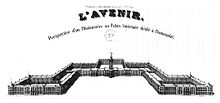
A phalanstère (or phalanstery) was a type of building designed for a self-contained utopian community, ideally consisting of 500–2000 people working together for mutual benefit, and developed in the early 19th century by Charles Fourier. Fourier chose the name by combining the French word phalange (phalanx, an emblematic military unit in ancient Greece), with the word monastère (monastery).[1]
Structure
Fourier conceived the phalanstère as an organized building designed to integrate urban and rural features.
The structure of the phalanstère was composed of three parts: a central part and two lateral wings. The central part was designed for quiet activities. It included dining rooms, meeting rooms, libraries and studies. A lateral wing was designed for labour and noisy activities, such as carpentry, hammering and forging. It also hosted children because they were considered noisy while playing. The other wing contained a caravansary, with ballrooms and halls for meetings with outsiders who had to pay a fee in order to visit and meet the people of the Phalanx community. This income was thought to sustain the autonomous economy of the phalanstère. The phalanstère also included private apartments and many social halls. A social hall was defined by Fourier as a seristère.
In France and the United States
Though Fourier published several journals in Paris, among them La Phalanstère, he created no phalanstères in Europe due to a lack of financial support. Several so-called colonies were founded in the United States of America by Albert Brisbane and Horace Greeley.
Examples
- La Colonie of Condé-sur-Vesgre (1832)
- Phalanstery of Scăieni, Wallachia (1834)
- La Réunion in Dallas (1855)
- Familistère of Guise (1859)
- Familistère of Godin (1887)
- Longo Maï Co-operatives (1973)
- Uranian Phalanstery (1974)
Gender roles
Fourier believed that the traditional house was a place of exile and oppression of women. He believed gender roles could progress by shaping them within community, more than by pursuits of sexual freedom or other Simonian concepts.[2]

Legacy
In the 20th century, the architect Le Corbusier adapted the concept of the phalanstère when he designed the Unité d'Habitation, a self-contained commune, at Marseilles.[3]
In popular culture
The Phalanstères are mentioned several times in Gustave Flaubert's 1869 novel Sentimental Education: for example, among a list of utopian projects: "plans of phalansteria, projects for cantonal bazaars, systems of public felicity."[4]
In the Hungarian play The Tragedy of Man by Imre Madách, one of the later scenes takes place in a phalanstery, in a utopian future, where the entirety of humanity lives in phalansteries, there are no borders, no nations, and civilization is dominated by science.
In the PC game Tristania 3D, the evil Courbèe Dominate empire lives in a phalanstery (spelled "Falanster" in the game) somewhere near Norway, hidden from the rest of the world. In the game, the phalanstery is described as a gigantic city-state, consisting 7 major districts. The protagonist of the game must gain entry into the phalanstery, unfortunately it is very well protected. Eventually he does so, and most of the game takes place inside the phalanstery, although explicitly only level 15 bears the name "Falanster".
In the Booker prize-winning novel Possession by A. S. Byatt, ancestors of the antagonist Mortimer Cropper are described (p. 114) as having attempted to found a phalanstery in New Mexico.
In The Sisters Brothers by Jacques Audiard, Hermann Warm dreams of setting up a phalanstery.
See also
- Feminism in France
- Kibbutzim
- Oyasato-yakata
- Victor Prosper Considerant
References
- ^ Harper, Douglas. "phalanstery". Online Etymology Dictionary. Retrieved 2016-08-11.
- ^ "Feminism". Archived from the original on April 25, 2005.
- ^ Coleman, Nathaniel (2007). Utopias and Architecture. Routledge. p. 137. ISBN 978-1-135-99395-5.
- ^ Flaubert, Gustave (January 2, 2011). "Sentimental Education; Or, The History of a Young Man. Volume 1" – via Project Gutenberg.
